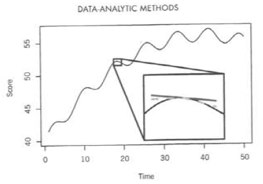This chapter introduces one approach to describing constructs that consist of easily reversed, short–term changes — data that is often dismissed as “error.” This chapter begins with calculating rates of change on many small segments of a time series, and how the current state of a variable can be related to how it is changing.
Abstract
This chapter introduces one approach to describing constructs that consist of easily reversed, short–term changes — data that is often dismissed as “error” or too complex to model. Short–term, relatively reversible changes in constructs have been described as intraindividual variability by Nesselroade (1991, 1984) and temporal instability by Ebner-Priemer and Trull (in this volume). This chapter begins with tools for describing rates of change, the idea of calculating rates of change on many small segments of a time series, and, finally, an example of how the current state of a variable can be related to how it is changing. These ideas will be introduced as differential equation modeling. Differential equation modeling holds promise for the modeling of intraindividual variability because of the way they allow researchers to understand relationships governing the momentary changes in a time series. Two methods for fitting differential equation models are described, using ordinary linear regression and structural equation modeling. The chapter ends with code for each of the two methods, written for the free statistical program R, and analysis of a sample time series.
Code and Other Content
DailyLifeHandbook.R
Citation
Deboeck, P. R. (2011). Modeling Non–Linear Dynamics. In M. R. Mehl & T. S. Conner (Eds.) The Handbook of Research Methods for Studying Daily Life, pp. 440–458. New York, NY: Guilford Press.
